Change Management and Leadership
VerifiedAdded on 2022/10/19
|12
|3657
|169
AI Summary
This document discusses Change Management and Leadership. It covers topics such as communicating, introducing and managing improvements, monitoring and reviewing changes, identifying opportunities for improvement, external and internal forces for change, and whether changes always equate with improvements. The document provides examples and strategies for effective change management and leadership. Course code, course name, and college/university are not mentioned.
Contribute Materials
Your contribution can guide someone’s learning journey. Share your
documents today.
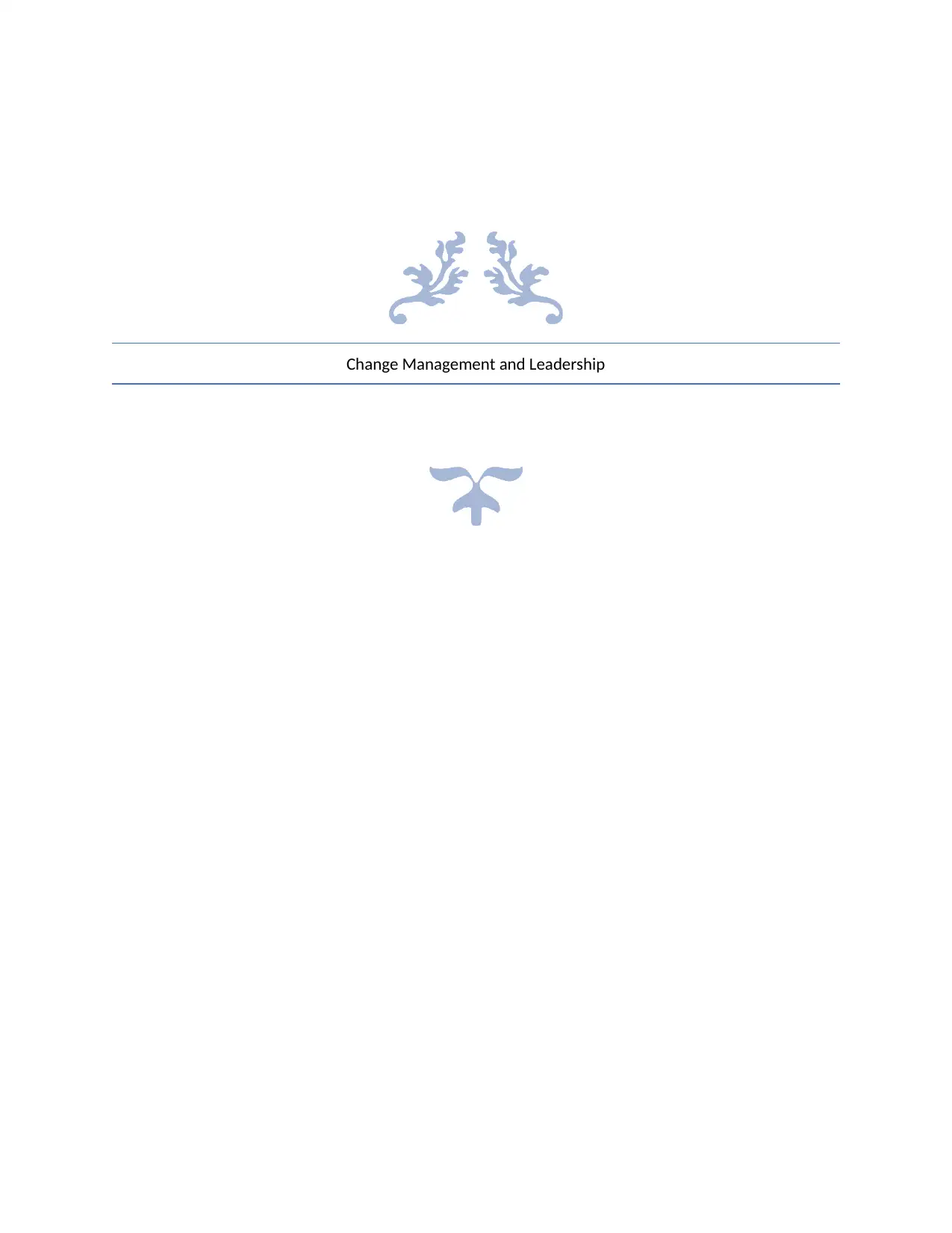
Change Management and Leadership
Secure Best Marks with AI Grader
Need help grading? Try our AI Grader for instant feedback on your assignments.
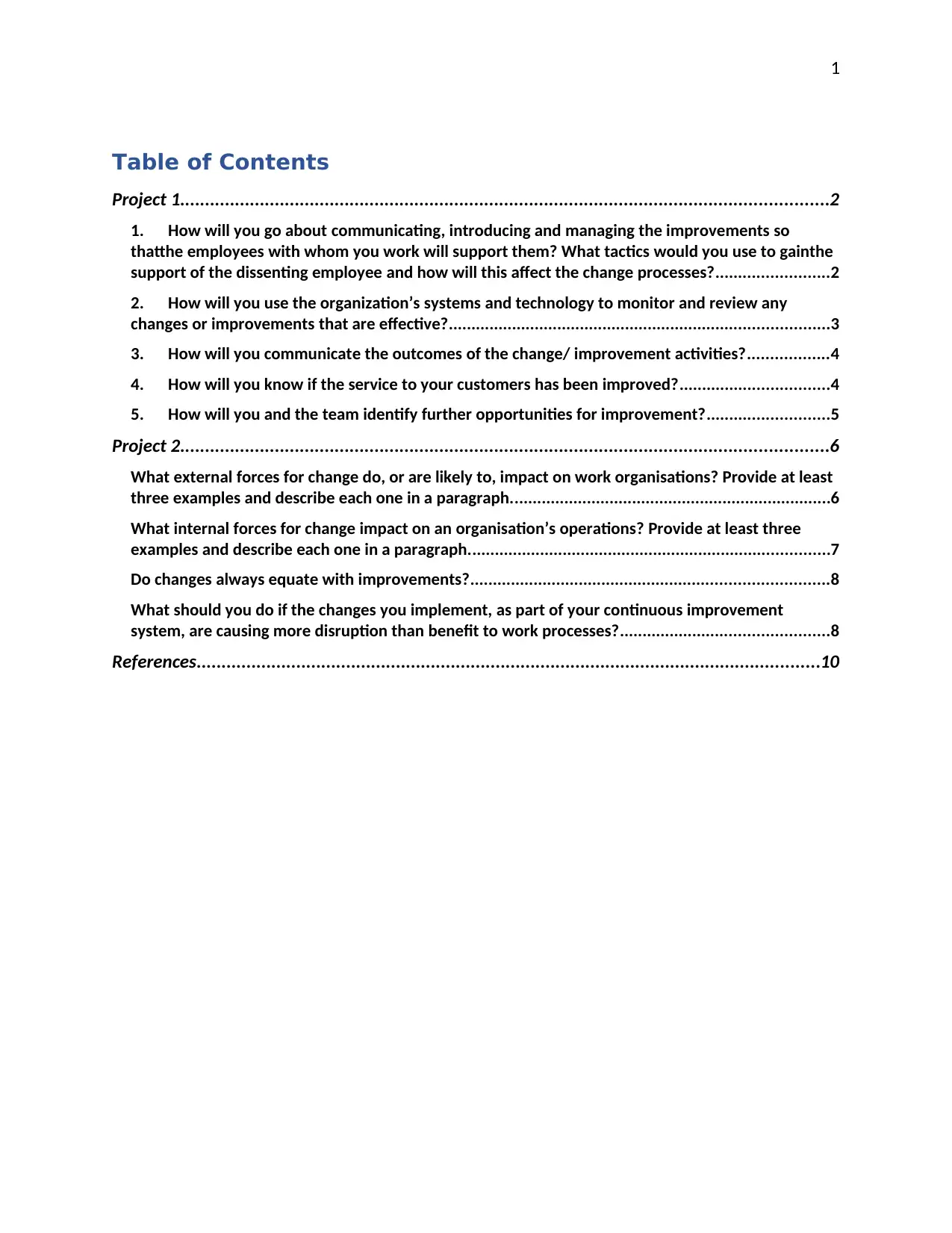
1
Table of Contents
Project 1..................................................................................................................................2
1. How will you go about communicating, introducing and managing the improvements so
thatthe employees with whom you work will support them? What tactics would you use to gainthe
support of the dissenting employee and how will this affect the change processes?.........................2
2. How will you use the organization’s systems and technology to monitor and review any
changes or improvements that are effective?....................................................................................3
3. How will you communicate the outcomes of the change/ improvement activities?..................4
4. How will you know if the service to your customers has been improved?.................................4
5. How will you and the team identify further opportunities for improvement?...........................5
Project 2..................................................................................................................................6
What external forces for change do, or are likely to, impact on work organisations? Provide at least
three examples and describe each one in a paragraph.......................................................................6
What internal forces for change impact on an organisation’s operations? Provide at least three
examples and describe each one in a paragraph................................................................................7
Do changes always equate with improvements?...............................................................................8
What should you do if the changes you implement, as part of your continuous improvement
system, are causing more disruption than benefit to work processes?..............................................8
References.............................................................................................................................10
Table of Contents
Project 1..................................................................................................................................2
1. How will you go about communicating, introducing and managing the improvements so
thatthe employees with whom you work will support them? What tactics would you use to gainthe
support of the dissenting employee and how will this affect the change processes?.........................2
2. How will you use the organization’s systems and technology to monitor and review any
changes or improvements that are effective?....................................................................................3
3. How will you communicate the outcomes of the change/ improvement activities?..................4
4. How will you know if the service to your customers has been improved?.................................4
5. How will you and the team identify further opportunities for improvement?...........................5
Project 2..................................................................................................................................6
What external forces for change do, or are likely to, impact on work organisations? Provide at least
three examples and describe each one in a paragraph.......................................................................6
What internal forces for change impact on an organisation’s operations? Provide at least three
examples and describe each one in a paragraph................................................................................7
Do changes always equate with improvements?...............................................................................8
What should you do if the changes you implement, as part of your continuous improvement
system, are causing more disruption than benefit to work processes?..............................................8
References.............................................................................................................................10
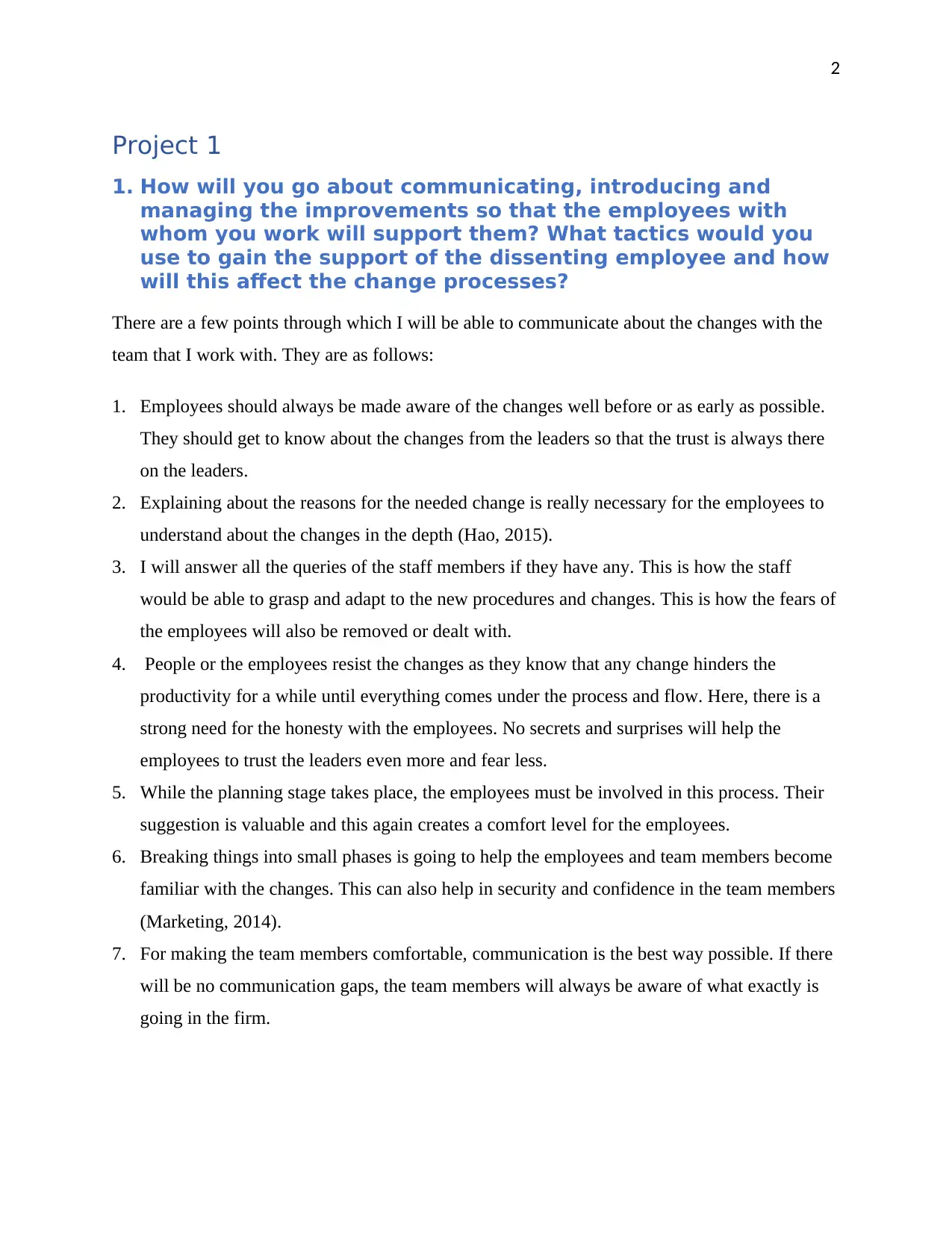
2
Project 1
1. How will you go about communicating, introducing and
managing the improvements so that the employees with
whom you work will support them? What tactics would you
use to gain the support of the dissenting employee and how
will this affect the change processes?
There are a few points through which I will be able to communicate about the changes with the
team that I work with. They are as follows:
1. Employees should always be made aware of the changes well before or as early as possible.
They should get to know about the changes from the leaders so that the trust is always there
on the leaders.
2. Explaining about the reasons for the needed change is really necessary for the employees to
understand about the changes in the depth (Hao, 2015).
3. I will answer all the queries of the staff members if they have any. This is how the staff
would be able to grasp and adapt to the new procedures and changes. This is how the fears of
the employees will also be removed or dealt with.
4. People or the employees resist the changes as they know that any change hinders the
productivity for a while until everything comes under the process and flow. Here, there is a
strong need for the honesty with the employees. No secrets and surprises will help the
employees to trust the leaders even more and fear less.
5. While the planning stage takes place, the employees must be involved in this process. Their
suggestion is valuable and this again creates a comfort level for the employees.
6. Breaking things into small phases is going to help the employees and team members become
familiar with the changes. This can also help in security and confidence in the team members
(Marketing, 2014).
7. For making the team members comfortable, communication is the best way possible. If there
will be no communication gaps, the team members will always be aware of what exactly is
going in the firm.
Project 1
1. How will you go about communicating, introducing and
managing the improvements so that the employees with
whom you work will support them? What tactics would you
use to gain the support of the dissenting employee and how
will this affect the change processes?
There are a few points through which I will be able to communicate about the changes with the
team that I work with. They are as follows:
1. Employees should always be made aware of the changes well before or as early as possible.
They should get to know about the changes from the leaders so that the trust is always there
on the leaders.
2. Explaining about the reasons for the needed change is really necessary for the employees to
understand about the changes in the depth (Hao, 2015).
3. I will answer all the queries of the staff members if they have any. This is how the staff
would be able to grasp and adapt to the new procedures and changes. This is how the fears of
the employees will also be removed or dealt with.
4. People or the employees resist the changes as they know that any change hinders the
productivity for a while until everything comes under the process and flow. Here, there is a
strong need for the honesty with the employees. No secrets and surprises will help the
employees to trust the leaders even more and fear less.
5. While the planning stage takes place, the employees must be involved in this process. Their
suggestion is valuable and this again creates a comfort level for the employees.
6. Breaking things into small phases is going to help the employees and team members become
familiar with the changes. This can also help in security and confidence in the team members
(Marketing, 2014).
7. For making the team members comfortable, communication is the best way possible. If there
will be no communication gaps, the team members will always be aware of what exactly is
going in the firm.
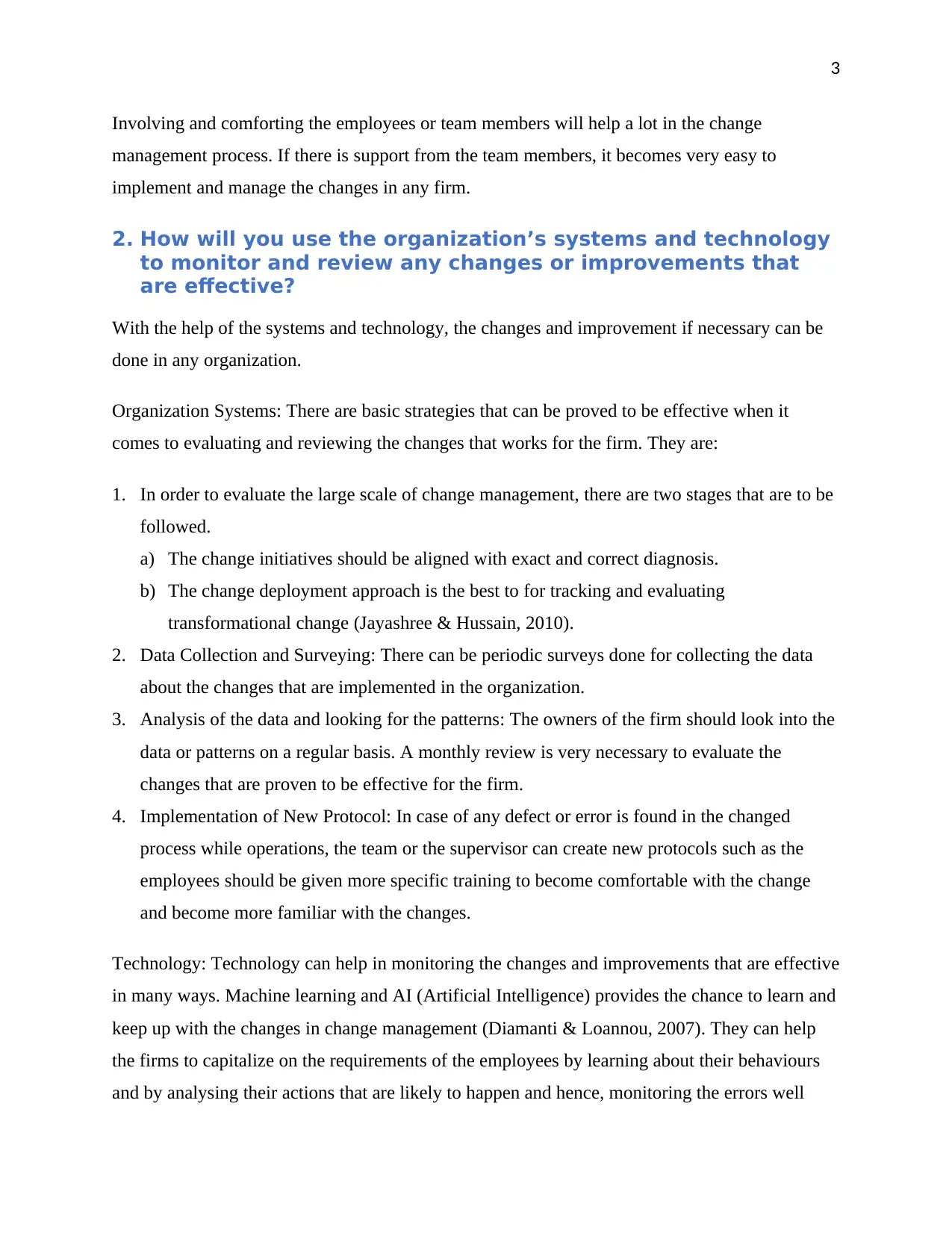
3
Involving and comforting the employees or team members will help a lot in the change
management process. If there is support from the team members, it becomes very easy to
implement and manage the changes in any firm.
2. How will you use the organization’s systems and technology
to monitor and review any changes or improvements that
are effective?
With the help of the systems and technology, the changes and improvement if necessary can be
done in any organization.
Organization Systems: There are basic strategies that can be proved to be effective when it
comes to evaluating and reviewing the changes that works for the firm. They are:
1. In order to evaluate the large scale of change management, there are two stages that are to be
followed.
a) The change initiatives should be aligned with exact and correct diagnosis.
b) The change deployment approach is the best to for tracking and evaluating
transformational change (Jayashree & Hussain, 2010).
2. Data Collection and Surveying: There can be periodic surveys done for collecting the data
about the changes that are implemented in the organization.
3. Analysis of the data and looking for the patterns: The owners of the firm should look into the
data or patterns on a regular basis. A monthly review is very necessary to evaluate the
changes that are proven to be effective for the firm.
4. Implementation of New Protocol: In case of any defect or error is found in the changed
process while operations, the team or the supervisor can create new protocols such as the
employees should be given more specific training to become comfortable with the change
and become more familiar with the changes.
Technology: Technology can help in monitoring the changes and improvements that are effective
in many ways. Machine learning and AI (Artificial Intelligence) provides the chance to learn and
keep up with the changes in change management (Diamanti & Loannou, 2007). They can help
the firms to capitalize on the requirements of the employees by learning about their behaviours
and by analysing their actions that are likely to happen and hence, monitoring the errors well
Involving and comforting the employees or team members will help a lot in the change
management process. If there is support from the team members, it becomes very easy to
implement and manage the changes in any firm.
2. How will you use the organization’s systems and technology
to monitor and review any changes or improvements that
are effective?
With the help of the systems and technology, the changes and improvement if necessary can be
done in any organization.
Organization Systems: There are basic strategies that can be proved to be effective when it
comes to evaluating and reviewing the changes that works for the firm. They are:
1. In order to evaluate the large scale of change management, there are two stages that are to be
followed.
a) The change initiatives should be aligned with exact and correct diagnosis.
b) The change deployment approach is the best to for tracking and evaluating
transformational change (Jayashree & Hussain, 2010).
2. Data Collection and Surveying: There can be periodic surveys done for collecting the data
about the changes that are implemented in the organization.
3. Analysis of the data and looking for the patterns: The owners of the firm should look into the
data or patterns on a regular basis. A monthly review is very necessary to evaluate the
changes that are proven to be effective for the firm.
4. Implementation of New Protocol: In case of any defect or error is found in the changed
process while operations, the team or the supervisor can create new protocols such as the
employees should be given more specific training to become comfortable with the change
and become more familiar with the changes.
Technology: Technology can help in monitoring the changes and improvements that are effective
in many ways. Machine learning and AI (Artificial Intelligence) provides the chance to learn and
keep up with the changes in change management (Diamanti & Loannou, 2007). They can help
the firms to capitalize on the requirements of the employees by learning about their behaviours
and by analysing their actions that are likely to happen and hence, monitoring the errors well
Secure Best Marks with AI Grader
Need help grading? Try our AI Grader for instant feedback on your assignments.
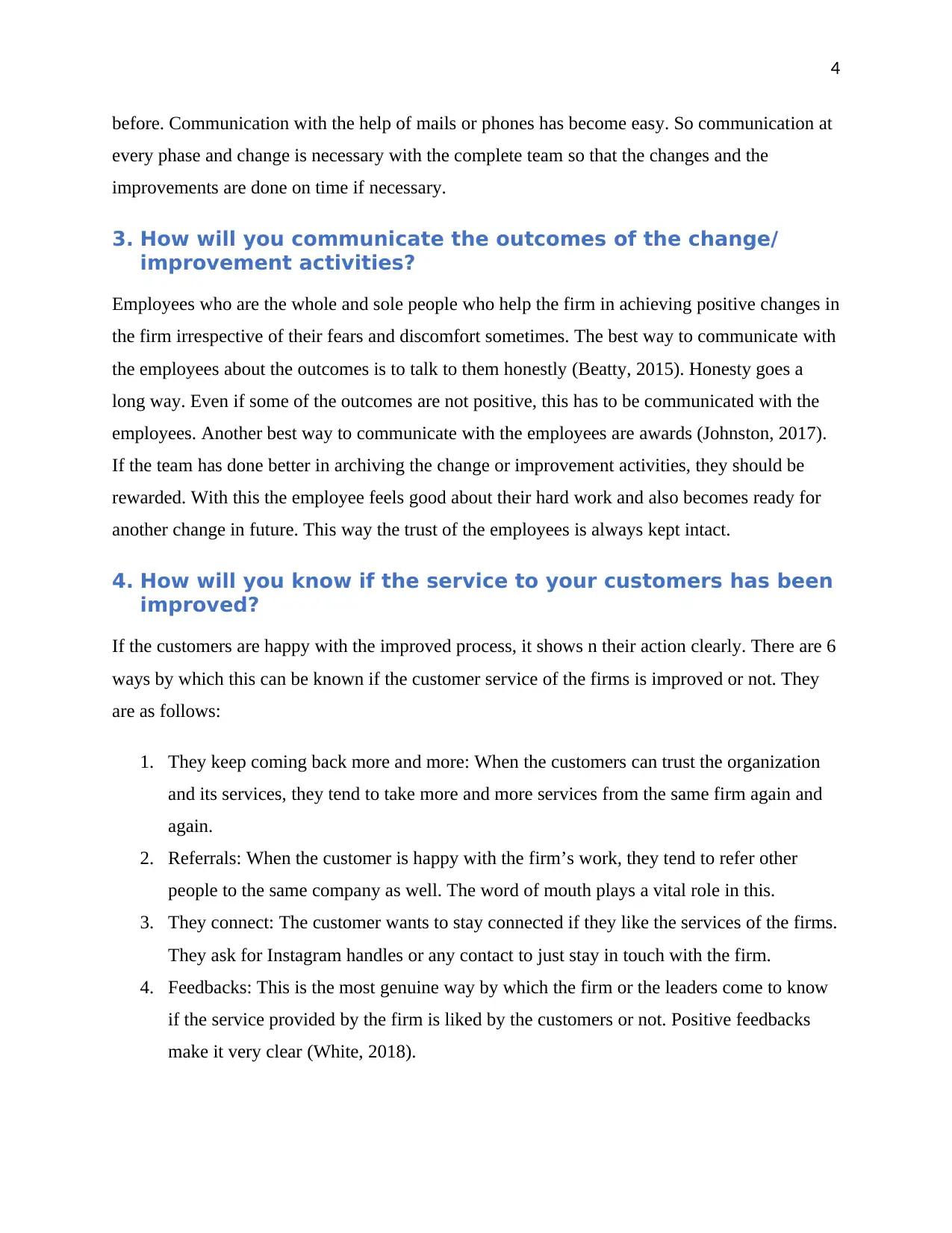
4
before. Communication with the help of mails or phones has become easy. So communication at
every phase and change is necessary with the complete team so that the changes and the
improvements are done on time if necessary.
3. How will you communicate the outcomes of the change/
improvement activities?
Employees who are the whole and sole people who help the firm in achieving positive changes in
the firm irrespective of their fears and discomfort sometimes. The best way to communicate with
the employees about the outcomes is to talk to them honestly (Beatty, 2015). Honesty goes a
long way. Even if some of the outcomes are not positive, this has to be communicated with the
employees. Another best way to communicate with the employees are awards (Johnston, 2017).
If the team has done better in archiving the change or improvement activities, they should be
rewarded. With this the employee feels good about their hard work and also becomes ready for
another change in future. This way the trust of the employees is always kept intact.
4. How will you know if the service to your customers has been
improved?
If the customers are happy with the improved process, it shows n their action clearly. There are 6
ways by which this can be known if the customer service of the firms is improved or not. They
are as follows:
1. They keep coming back more and more: When the customers can trust the organization
and its services, they tend to take more and more services from the same firm again and
again.
2. Referrals: When the customer is happy with the firm’s work, they tend to refer other
people to the same company as well. The word of mouth plays a vital role in this.
3. They connect: The customer wants to stay connected if they like the services of the firms.
They ask for Instagram handles or any contact to just stay in touch with the firm.
4. Feedbacks: This is the most genuine way by which the firm or the leaders come to know
if the service provided by the firm is liked by the customers or not. Positive feedbacks
make it very clear (White, 2018).
before. Communication with the help of mails or phones has become easy. So communication at
every phase and change is necessary with the complete team so that the changes and the
improvements are done on time if necessary.
3. How will you communicate the outcomes of the change/
improvement activities?
Employees who are the whole and sole people who help the firm in achieving positive changes in
the firm irrespective of their fears and discomfort sometimes. The best way to communicate with
the employees about the outcomes is to talk to them honestly (Beatty, 2015). Honesty goes a
long way. Even if some of the outcomes are not positive, this has to be communicated with the
employees. Another best way to communicate with the employees are awards (Johnston, 2017).
If the team has done better in archiving the change or improvement activities, they should be
rewarded. With this the employee feels good about their hard work and also becomes ready for
another change in future. This way the trust of the employees is always kept intact.
4. How will you know if the service to your customers has been
improved?
If the customers are happy with the improved process, it shows n their action clearly. There are 6
ways by which this can be known if the customer service of the firms is improved or not. They
are as follows:
1. They keep coming back more and more: When the customers can trust the organization
and its services, they tend to take more and more services from the same firm again and
again.
2. Referrals: When the customer is happy with the firm’s work, they tend to refer other
people to the same company as well. The word of mouth plays a vital role in this.
3. They connect: The customer wants to stay connected if they like the services of the firms.
They ask for Instagram handles or any contact to just stay in touch with the firm.
4. Feedbacks: This is the most genuine way by which the firm or the leaders come to know
if the service provided by the firm is liked by the customers or not. Positive feedbacks
make it very clear (White, 2018).
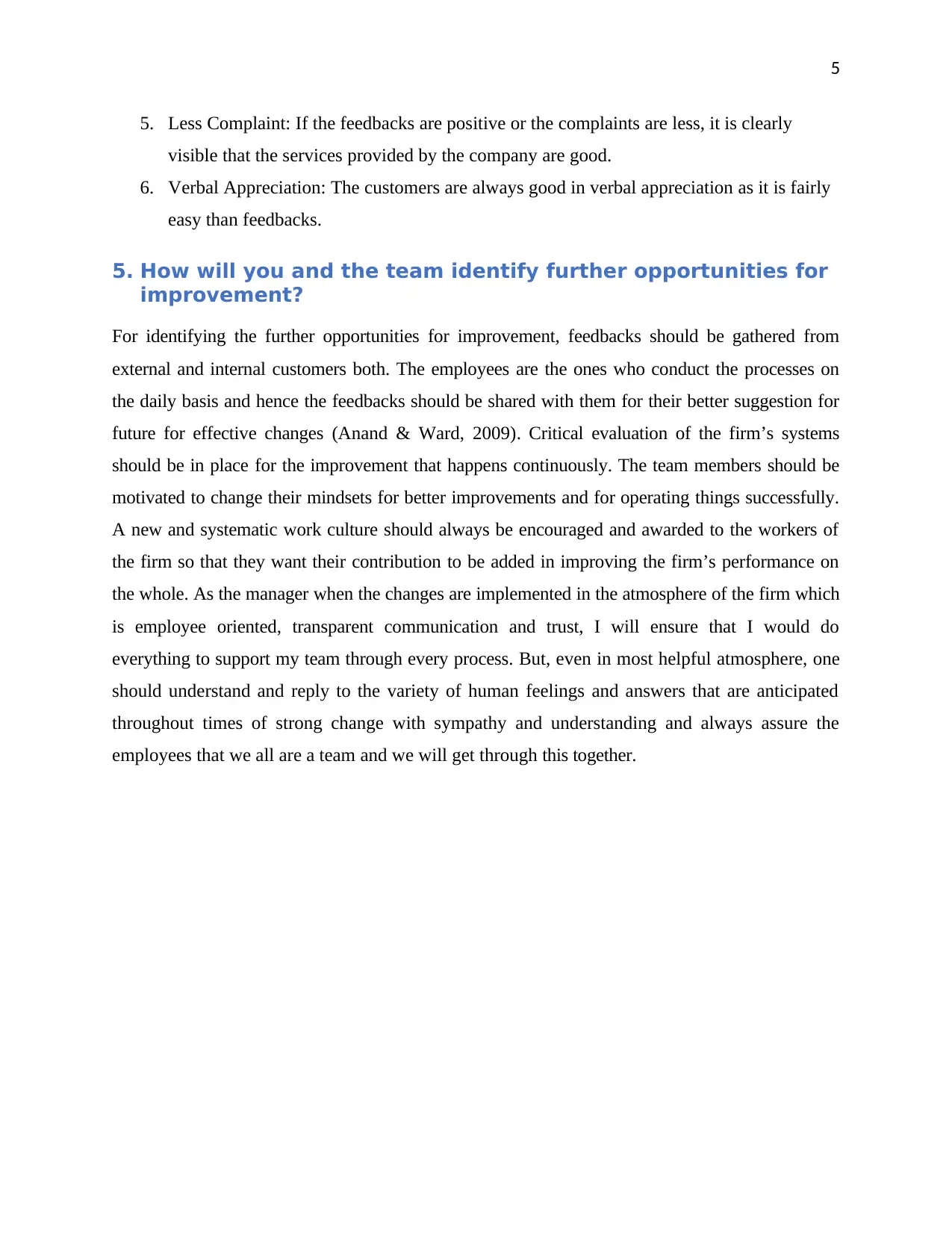
5
5. Less Complaint: If the feedbacks are positive or the complaints are less, it is clearly
visible that the services provided by the company are good.
6. Verbal Appreciation: The customers are always good in verbal appreciation as it is fairly
easy than feedbacks.
5. How will you and the team identify further opportunities for
improvement?
For identifying the further opportunities for improvement, feedbacks should be gathered from
external and internal customers both. The employees are the ones who conduct the processes on
the daily basis and hence the feedbacks should be shared with them for their better suggestion for
future for effective changes (Anand & Ward, 2009). Critical evaluation of the firm’s systems
should be in place for the improvement that happens continuously. The team members should be
motivated to change their mindsets for better improvements and for operating things successfully.
A new and systematic work culture should always be encouraged and awarded to the workers of
the firm so that they want their contribution to be added in improving the firm’s performance on
the whole. As the manager when the changes are implemented in the atmosphere of the firm which
is employee oriented, transparent communication and trust, I will ensure that I would do
everything to support my team through every process. But, even in most helpful atmosphere, one
should understand and reply to the variety of human feelings and answers that are anticipated
throughout times of strong change with sympathy and understanding and always assure the
employees that we all are a team and we will get through this together.
5. Less Complaint: If the feedbacks are positive or the complaints are less, it is clearly
visible that the services provided by the company are good.
6. Verbal Appreciation: The customers are always good in verbal appreciation as it is fairly
easy than feedbacks.
5. How will you and the team identify further opportunities for
improvement?
For identifying the further opportunities for improvement, feedbacks should be gathered from
external and internal customers both. The employees are the ones who conduct the processes on
the daily basis and hence the feedbacks should be shared with them for their better suggestion for
future for effective changes (Anand & Ward, 2009). Critical evaluation of the firm’s systems
should be in place for the improvement that happens continuously. The team members should be
motivated to change their mindsets for better improvements and for operating things successfully.
A new and systematic work culture should always be encouraged and awarded to the workers of
the firm so that they want their contribution to be added in improving the firm’s performance on
the whole. As the manager when the changes are implemented in the atmosphere of the firm which
is employee oriented, transparent communication and trust, I will ensure that I would do
everything to support my team through every process. But, even in most helpful atmosphere, one
should understand and reply to the variety of human feelings and answers that are anticipated
throughout times of strong change with sympathy and understanding and always assure the
employees that we all are a team and we will get through this together.
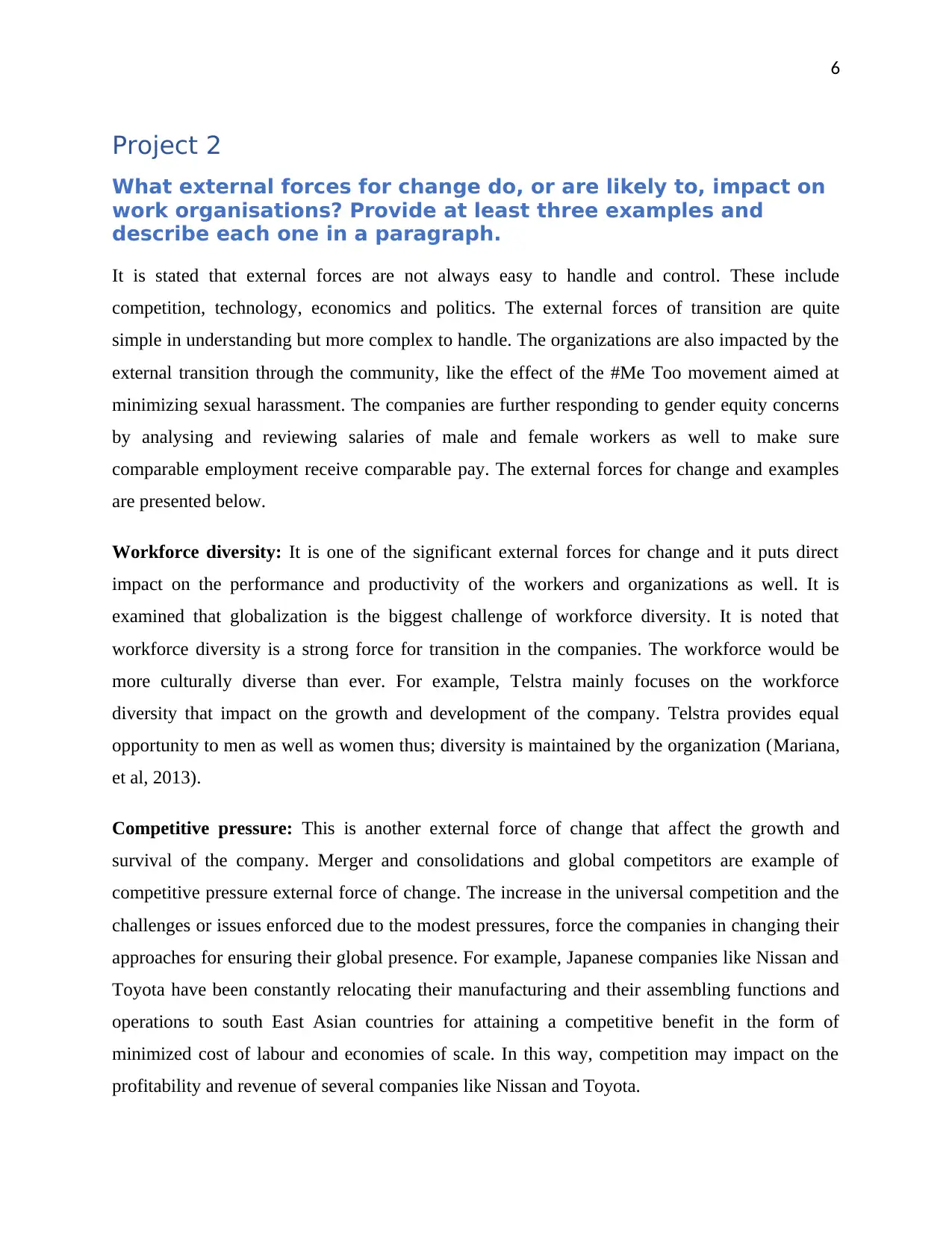
6
Project 2
What external forces for change do, or are likely to, impact on
work organisations? Provide at least three examples and
describe each one in a paragraph.
It is stated that external forces are not always easy to handle and control. These include
competition, technology, economics and politics. The external forces of transition are quite
simple in understanding but more complex to handle. The organizations are also impacted by the
external transition through the community, like the effect of the #Me Too movement aimed at
minimizing sexual harassment. The companies are further responding to gender equity concerns
by analysing and reviewing salaries of male and female workers as well to make sure
comparable employment receive comparable pay. The external forces for change and examples
are presented below.
Workforce diversity: It is one of the significant external forces for change and it puts direct
impact on the performance and productivity of the workers and organizations as well. It is
examined that globalization is the biggest challenge of workforce diversity. It is noted that
workforce diversity is a strong force for transition in the companies. The workforce would be
more culturally diverse than ever. For example, Telstra mainly focuses on the workforce
diversity that impact on the growth and development of the company. Telstra provides equal
opportunity to men as well as women thus; diversity is maintained by the organization (Mariana,
et al, 2013).
Competitive pressure: This is another external force of change that affect the growth and
survival of the company. Merger and consolidations and global competitors are example of
competitive pressure external force of change. The increase in the universal competition and the
challenges or issues enforced due to the modest pressures, force the companies in changing their
approaches for ensuring their global presence. For example, Japanese companies like Nissan and
Toyota have been constantly relocating their manufacturing and their assembling functions and
operations to south East Asian countries for attaining a competitive benefit in the form of
minimized cost of labour and economies of scale. In this way, competition may impact on the
profitability and revenue of several companies like Nissan and Toyota.
Project 2
What external forces for change do, or are likely to, impact on
work organisations? Provide at least three examples and
describe each one in a paragraph.
It is stated that external forces are not always easy to handle and control. These include
competition, technology, economics and politics. The external forces of transition are quite
simple in understanding but more complex to handle. The organizations are also impacted by the
external transition through the community, like the effect of the #Me Too movement aimed at
minimizing sexual harassment. The companies are further responding to gender equity concerns
by analysing and reviewing salaries of male and female workers as well to make sure
comparable employment receive comparable pay. The external forces for change and examples
are presented below.
Workforce diversity: It is one of the significant external forces for change and it puts direct
impact on the performance and productivity of the workers and organizations as well. It is
examined that globalization is the biggest challenge of workforce diversity. It is noted that
workforce diversity is a strong force for transition in the companies. The workforce would be
more culturally diverse than ever. For example, Telstra mainly focuses on the workforce
diversity that impact on the growth and development of the company. Telstra provides equal
opportunity to men as well as women thus; diversity is maintained by the organization (Mariana,
et al, 2013).
Competitive pressure: This is another external force of change that affect the growth and
survival of the company. Merger and consolidations and global competitors are example of
competitive pressure external force of change. The increase in the universal competition and the
challenges or issues enforced due to the modest pressures, force the companies in changing their
approaches for ensuring their global presence. For example, Japanese companies like Nissan and
Toyota have been constantly relocating their manufacturing and their assembling functions and
operations to south East Asian countries for attaining a competitive benefit in the form of
minimized cost of labour and economies of scale. In this way, competition may impact on the
profitability and revenue of several companies like Nissan and Toyota.
Paraphrase This Document
Need a fresh take? Get an instant paraphrase of this document with our AI Paraphraser
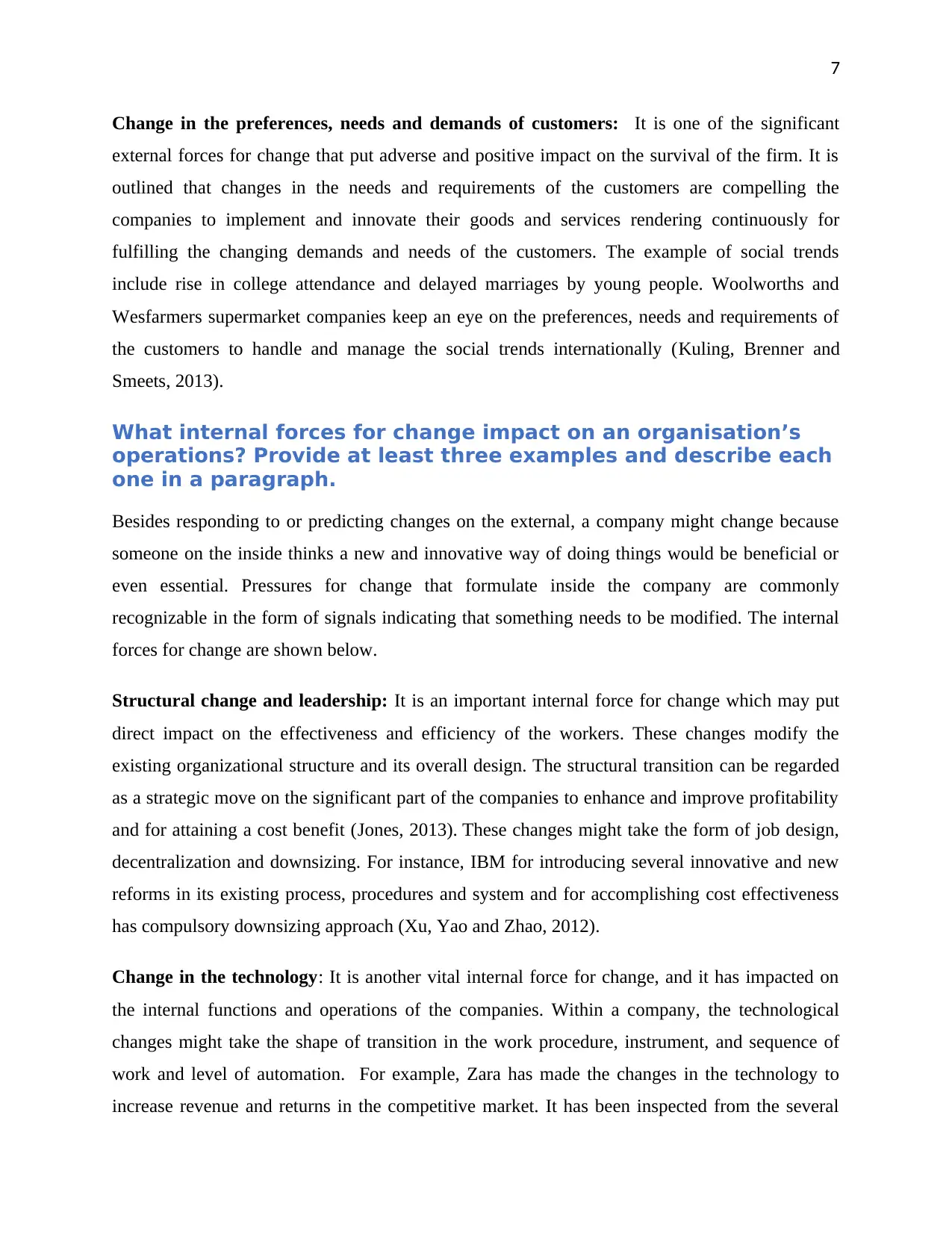
7
Change in the preferences, needs and demands of customers: It is one of the significant
external forces for change that put adverse and positive impact on the survival of the firm. It is
outlined that changes in the needs and requirements of the customers are compelling the
companies to implement and innovate their goods and services rendering continuously for
fulfilling the changing demands and needs of the customers. The example of social trends
include rise in college attendance and delayed marriages by young people. Woolworths and
Wesfarmers supermarket companies keep an eye on the preferences, needs and requirements of
the customers to handle and manage the social trends internationally (Kuling, Brenner and
Smeets, 2013).
What internal forces for change impact on an organisation’s
operations? Provide at least three examples and describe each
one in a paragraph.
Besides responding to or predicting changes on the external, a company might change because
someone on the inside thinks a new and innovative way of doing things would be beneficial or
even essential. Pressures for change that formulate inside the company are commonly
recognizable in the form of signals indicating that something needs to be modified. The internal
forces for change are shown below.
Structural change and leadership: It is an important internal force for change which may put
direct impact on the effectiveness and efficiency of the workers. These changes modify the
existing organizational structure and its overall design. The structural transition can be regarded
as a strategic move on the significant part of the companies to enhance and improve profitability
and for attaining a cost benefit (Jones, 2013). These changes might take the form of job design,
decentralization and downsizing. For instance, IBM for introducing several innovative and new
reforms in its existing process, procedures and system and for accomplishing cost effectiveness
has compulsory downsizing approach (Xu, Yao and Zhao, 2012).
Change in the technology: It is another vital internal force for change, and it has impacted on
the internal functions and operations of the companies. Within a company, the technological
changes might take the shape of transition in the work procedure, instrument, and sequence of
work and level of automation. For example, Zara has made the changes in the technology to
increase revenue and returns in the competitive market. It has been inspected from the several
Change in the preferences, needs and demands of customers: It is one of the significant
external forces for change that put adverse and positive impact on the survival of the firm. It is
outlined that changes in the needs and requirements of the customers are compelling the
companies to implement and innovate their goods and services rendering continuously for
fulfilling the changing demands and needs of the customers. The example of social trends
include rise in college attendance and delayed marriages by young people. Woolworths and
Wesfarmers supermarket companies keep an eye on the preferences, needs and requirements of
the customers to handle and manage the social trends internationally (Kuling, Brenner and
Smeets, 2013).
What internal forces for change impact on an organisation’s
operations? Provide at least three examples and describe each
one in a paragraph.
Besides responding to or predicting changes on the external, a company might change because
someone on the inside thinks a new and innovative way of doing things would be beneficial or
even essential. Pressures for change that formulate inside the company are commonly
recognizable in the form of signals indicating that something needs to be modified. The internal
forces for change are shown below.
Structural change and leadership: It is an important internal force for change which may put
direct impact on the effectiveness and efficiency of the workers. These changes modify the
existing organizational structure and its overall design. The structural transition can be regarded
as a strategic move on the significant part of the companies to enhance and improve profitability
and for attaining a cost benefit (Jones, 2013). These changes might take the form of job design,
decentralization and downsizing. For instance, IBM for introducing several innovative and new
reforms in its existing process, procedures and system and for accomplishing cost effectiveness
has compulsory downsizing approach (Xu, Yao and Zhao, 2012).
Change in the technology: It is another vital internal force for change, and it has impacted on
the internal functions and operations of the companies. Within a company, the technological
changes might take the shape of transition in the work procedure, instrument, and sequence of
work and level of automation. For example, Zara has made the changes in the technology to
increase revenue and returns in the competitive market. It has been inspected from the several
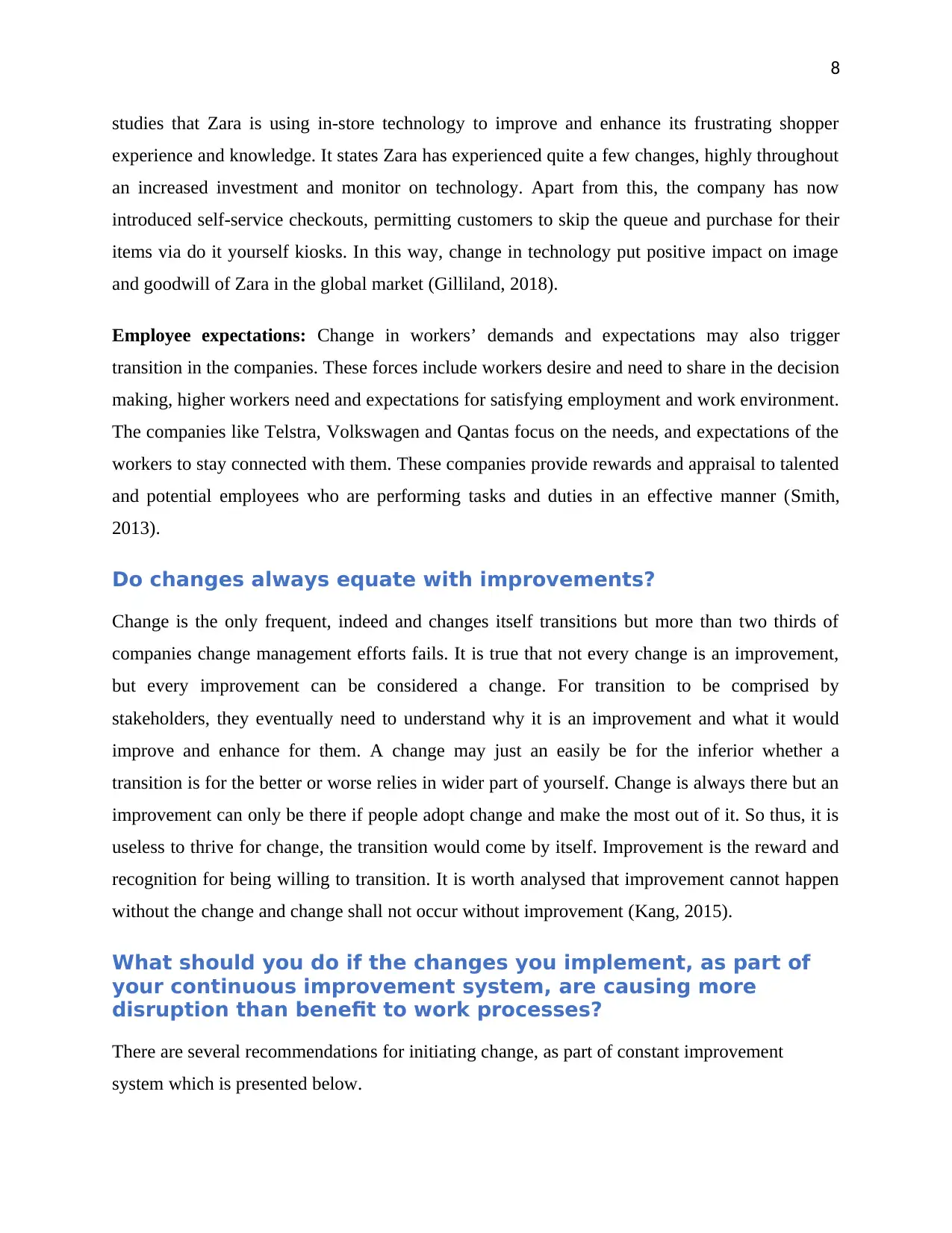
8
studies that Zara is using in-store technology to improve and enhance its frustrating shopper
experience and knowledge. It states Zara has experienced quite a few changes, highly throughout
an increased investment and monitor on technology. Apart from this, the company has now
introduced self-service checkouts, permitting customers to skip the queue and purchase for their
items via do it yourself kiosks. In this way, change in technology put positive impact on image
and goodwill of Zara in the global market (Gilliland, 2018).
Employee expectations: Change in workers’ demands and expectations may also trigger
transition in the companies. These forces include workers desire and need to share in the decision
making, higher workers need and expectations for satisfying employment and work environment.
The companies like Telstra, Volkswagen and Qantas focus on the needs, and expectations of the
workers to stay connected with them. These companies provide rewards and appraisal to talented
and potential employees who are performing tasks and duties in an effective manner (Smith,
2013).
Do changes always equate with improvements?
Change is the only frequent, indeed and changes itself transitions but more than two thirds of
companies change management efforts fails. It is true that not every change is an improvement,
but every improvement can be considered a change. For transition to be comprised by
stakeholders, they eventually need to understand why it is an improvement and what it would
improve and enhance for them. A change may just an easily be for the inferior whether a
transition is for the better or worse relies in wider part of yourself. Change is always there but an
improvement can only be there if people adopt change and make the most out of it. So thus, it is
useless to thrive for change, the transition would come by itself. Improvement is the reward and
recognition for being willing to transition. It is worth analysed that improvement cannot happen
without the change and change shall not occur without improvement (Kang, 2015).
What should you do if the changes you implement, as part of
your continuous improvement system, are causing more
disruption than benefit to work processes?
There are several recommendations for initiating change, as part of constant improvement
system which is presented below.
studies that Zara is using in-store technology to improve and enhance its frustrating shopper
experience and knowledge. It states Zara has experienced quite a few changes, highly throughout
an increased investment and monitor on technology. Apart from this, the company has now
introduced self-service checkouts, permitting customers to skip the queue and purchase for their
items via do it yourself kiosks. In this way, change in technology put positive impact on image
and goodwill of Zara in the global market (Gilliland, 2018).
Employee expectations: Change in workers’ demands and expectations may also trigger
transition in the companies. These forces include workers desire and need to share in the decision
making, higher workers need and expectations for satisfying employment and work environment.
The companies like Telstra, Volkswagen and Qantas focus on the needs, and expectations of the
workers to stay connected with them. These companies provide rewards and appraisal to talented
and potential employees who are performing tasks and duties in an effective manner (Smith,
2013).
Do changes always equate with improvements?
Change is the only frequent, indeed and changes itself transitions but more than two thirds of
companies change management efforts fails. It is true that not every change is an improvement,
but every improvement can be considered a change. For transition to be comprised by
stakeholders, they eventually need to understand why it is an improvement and what it would
improve and enhance for them. A change may just an easily be for the inferior whether a
transition is for the better or worse relies in wider part of yourself. Change is always there but an
improvement can only be there if people adopt change and make the most out of it. So thus, it is
useless to thrive for change, the transition would come by itself. Improvement is the reward and
recognition for being willing to transition. It is worth analysed that improvement cannot happen
without the change and change shall not occur without improvement (Kang, 2015).
What should you do if the changes you implement, as part of
your continuous improvement system, are causing more
disruption than benefit to work processes?
There are several recommendations for initiating change, as part of constant improvement
system which is presented below.
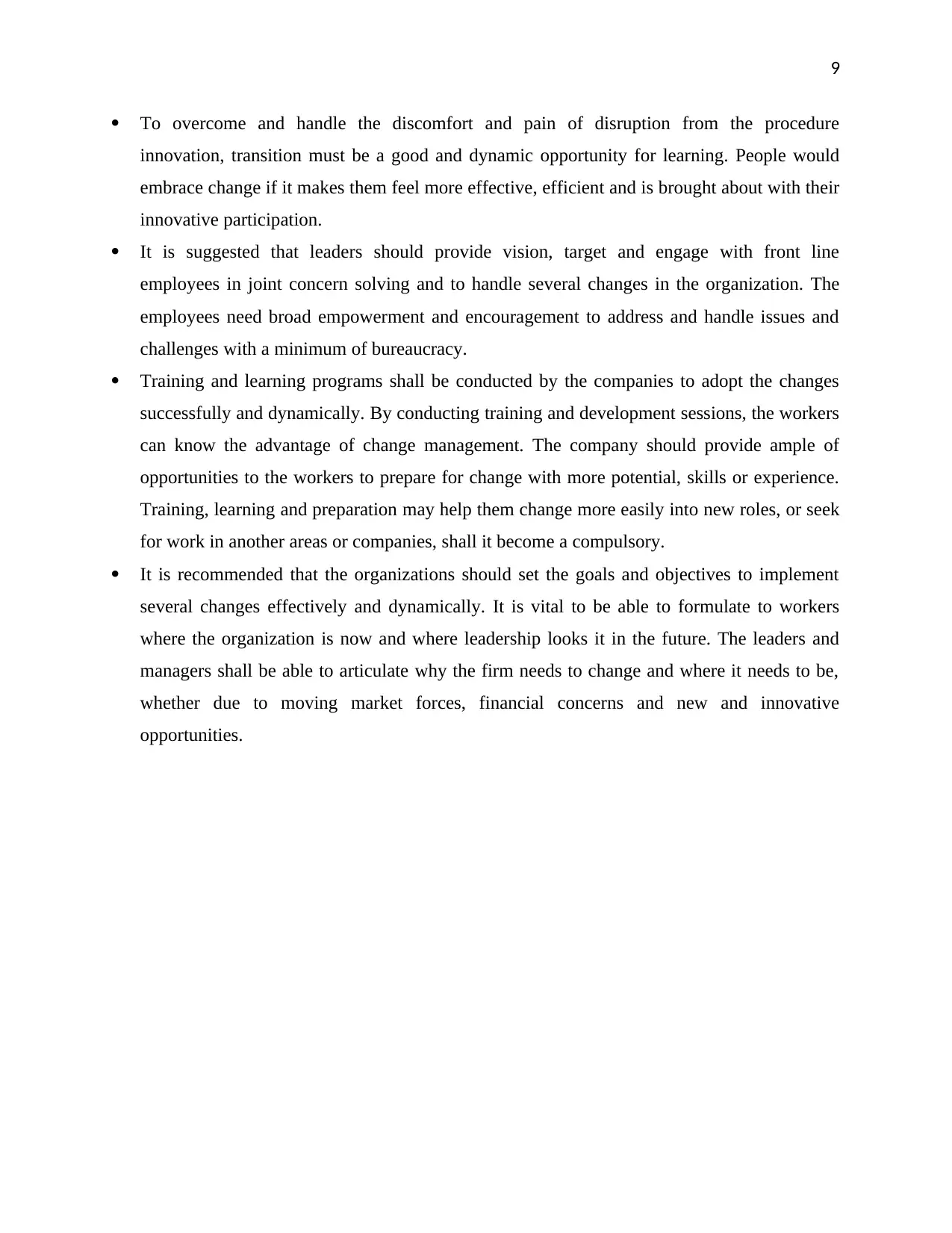
9
To overcome and handle the discomfort and pain of disruption from the procedure
innovation, transition must be a good and dynamic opportunity for learning. People would
embrace change if it makes them feel more effective, efficient and is brought about with their
innovative participation.
It is suggested that leaders should provide vision, target and engage with front line
employees in joint concern solving and to handle several changes in the organization. The
employees need broad empowerment and encouragement to address and handle issues and
challenges with a minimum of bureaucracy.
Training and learning programs shall be conducted by the companies to adopt the changes
successfully and dynamically. By conducting training and development sessions, the workers
can know the advantage of change management. The company should provide ample of
opportunities to the workers to prepare for change with more potential, skills or experience.
Training, learning and preparation may help them change more easily into new roles, or seek
for work in another areas or companies, shall it become a compulsory.
It is recommended that the organizations should set the goals and objectives to implement
several changes effectively and dynamically. It is vital to be able to formulate to workers
where the organization is now and where leadership looks it in the future. The leaders and
managers shall be able to articulate why the firm needs to change and where it needs to be,
whether due to moving market forces, financial concerns and new and innovative
opportunities.
To overcome and handle the discomfort and pain of disruption from the procedure
innovation, transition must be a good and dynamic opportunity for learning. People would
embrace change if it makes them feel more effective, efficient and is brought about with their
innovative participation.
It is suggested that leaders should provide vision, target and engage with front line
employees in joint concern solving and to handle several changes in the organization. The
employees need broad empowerment and encouragement to address and handle issues and
challenges with a minimum of bureaucracy.
Training and learning programs shall be conducted by the companies to adopt the changes
successfully and dynamically. By conducting training and development sessions, the workers
can know the advantage of change management. The company should provide ample of
opportunities to the workers to prepare for change with more potential, skills or experience.
Training, learning and preparation may help them change more easily into new roles, or seek
for work in another areas or companies, shall it become a compulsory.
It is recommended that the organizations should set the goals and objectives to implement
several changes effectively and dynamically. It is vital to be able to formulate to workers
where the organization is now and where leadership looks it in the future. The leaders and
managers shall be able to articulate why the firm needs to change and where it needs to be,
whether due to moving market forces, financial concerns and new and innovative
opportunities.
Secure Best Marks with AI Grader
Need help grading? Try our AI Grader for instant feedback on your assignments.
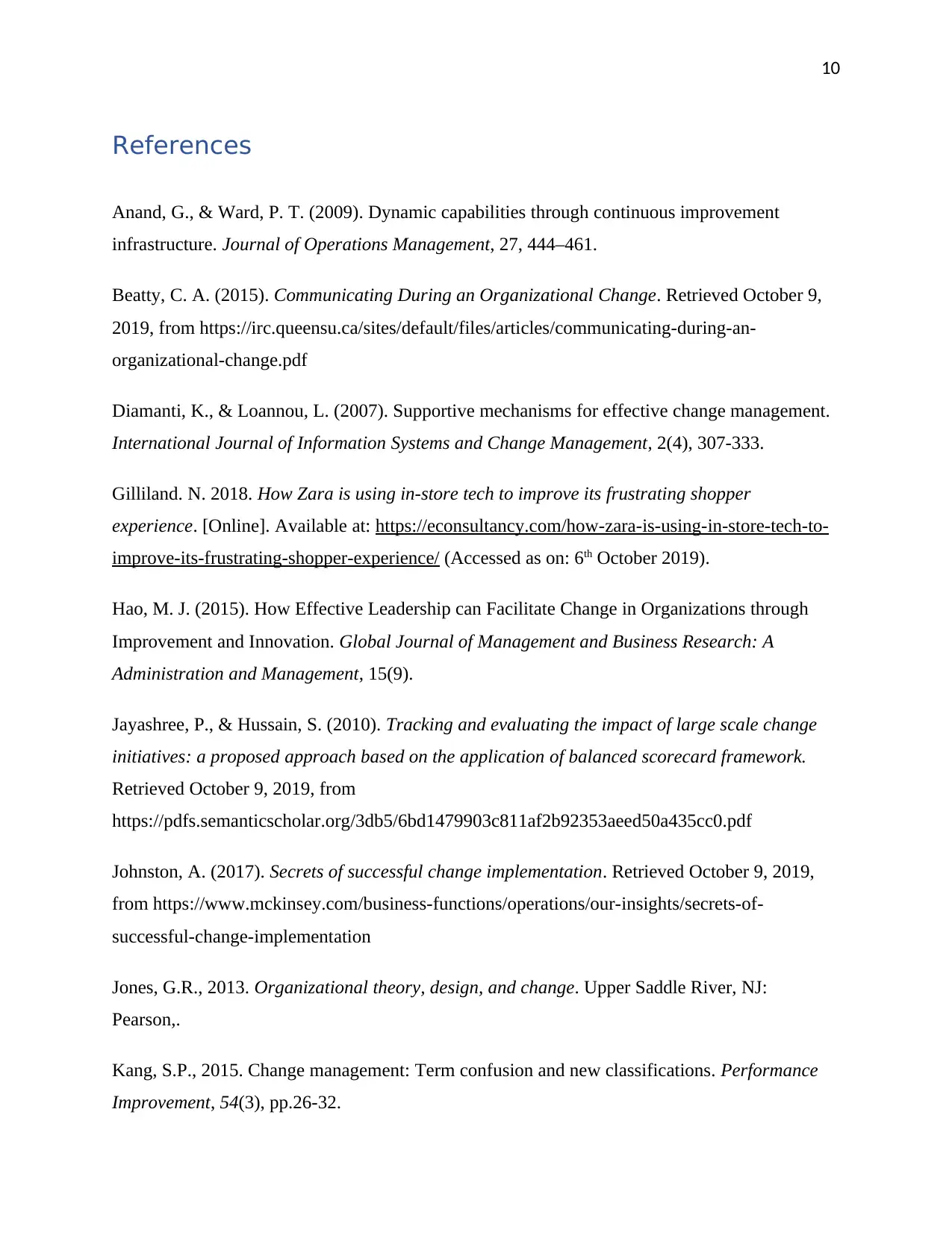
10
References
Anand, G., & Ward, P. T. (2009). Dynamic capabilities through continuous improvement
infrastructure. Journal of Operations Management, 27, 444–461.
Beatty, C. A. (2015). Communicating During an Organizational Change. Retrieved October 9,
2019, from https://irc.queensu.ca/sites/default/files/articles/communicating-during-an-
organizational-change.pdf
Diamanti, K., & Loannou, L. (2007). Supportive mechanisms for effective change management.
International Journal of Information Systems and Change Management, 2(4), 307-333.
Gilliland. N. 2018. How Zara is using in-store tech to improve its frustrating shopper
experience. [Online]. Available at: https://econsultancy.com/how-zara-is-using-in-store-tech-to-
improve-its-frustrating-shopper-experience/ (Accessed as on: 6th October 2019).
Hao, M. J. (2015). How Effective Leadership can Facilitate Change in Organizations through
Improvement and Innovation. Global Journal of Management and Business Research: A
Administration and Management, 15(9).
Jayashree, P., & Hussain, S. (2010). Tracking and evaluating the impact of large scale change
initiatives: a proposed approach based on the application of balanced scorecard framework.
Retrieved October 9, 2019, from
https://pdfs.semanticscholar.org/3db5/6bd1479903c811af2b92353aeed50a435cc0.pdf
Johnston, A. (2017). Secrets of successful change implementation. Retrieved October 9, 2019,
from https://www.mckinsey.com/business-functions/operations/our-insights/secrets-of-
successful-change-implementation
Jones, G.R., 2013. Organizational theory, design, and change. Upper Saddle River, NJ:
Pearson,.
Kang, S.P., 2015. Change management: Term confusion and new classifications. Performance
Improvement, 54(3), pp.26-32.
References
Anand, G., & Ward, P. T. (2009). Dynamic capabilities through continuous improvement
infrastructure. Journal of Operations Management, 27, 444–461.
Beatty, C. A. (2015). Communicating During an Organizational Change. Retrieved October 9,
2019, from https://irc.queensu.ca/sites/default/files/articles/communicating-during-an-
organizational-change.pdf
Diamanti, K., & Loannou, L. (2007). Supportive mechanisms for effective change management.
International Journal of Information Systems and Change Management, 2(4), 307-333.
Gilliland. N. 2018. How Zara is using in-store tech to improve its frustrating shopper
experience. [Online]. Available at: https://econsultancy.com/how-zara-is-using-in-store-tech-to-
improve-its-frustrating-shopper-experience/ (Accessed as on: 6th October 2019).
Hao, M. J. (2015). How Effective Leadership can Facilitate Change in Organizations through
Improvement and Innovation. Global Journal of Management and Business Research: A
Administration and Management, 15(9).
Jayashree, P., & Hussain, S. (2010). Tracking and evaluating the impact of large scale change
initiatives: a proposed approach based on the application of balanced scorecard framework.
Retrieved October 9, 2019, from
https://pdfs.semanticscholar.org/3db5/6bd1479903c811af2b92353aeed50a435cc0.pdf
Johnston, A. (2017). Secrets of successful change implementation. Retrieved October 9, 2019,
from https://www.mckinsey.com/business-functions/operations/our-insights/secrets-of-
successful-change-implementation
Jones, G.R., 2013. Organizational theory, design, and change. Upper Saddle River, NJ:
Pearson,.
Kang, S.P., 2015. Change management: Term confusion and new classifications. Performance
Improvement, 54(3), pp.26-32.
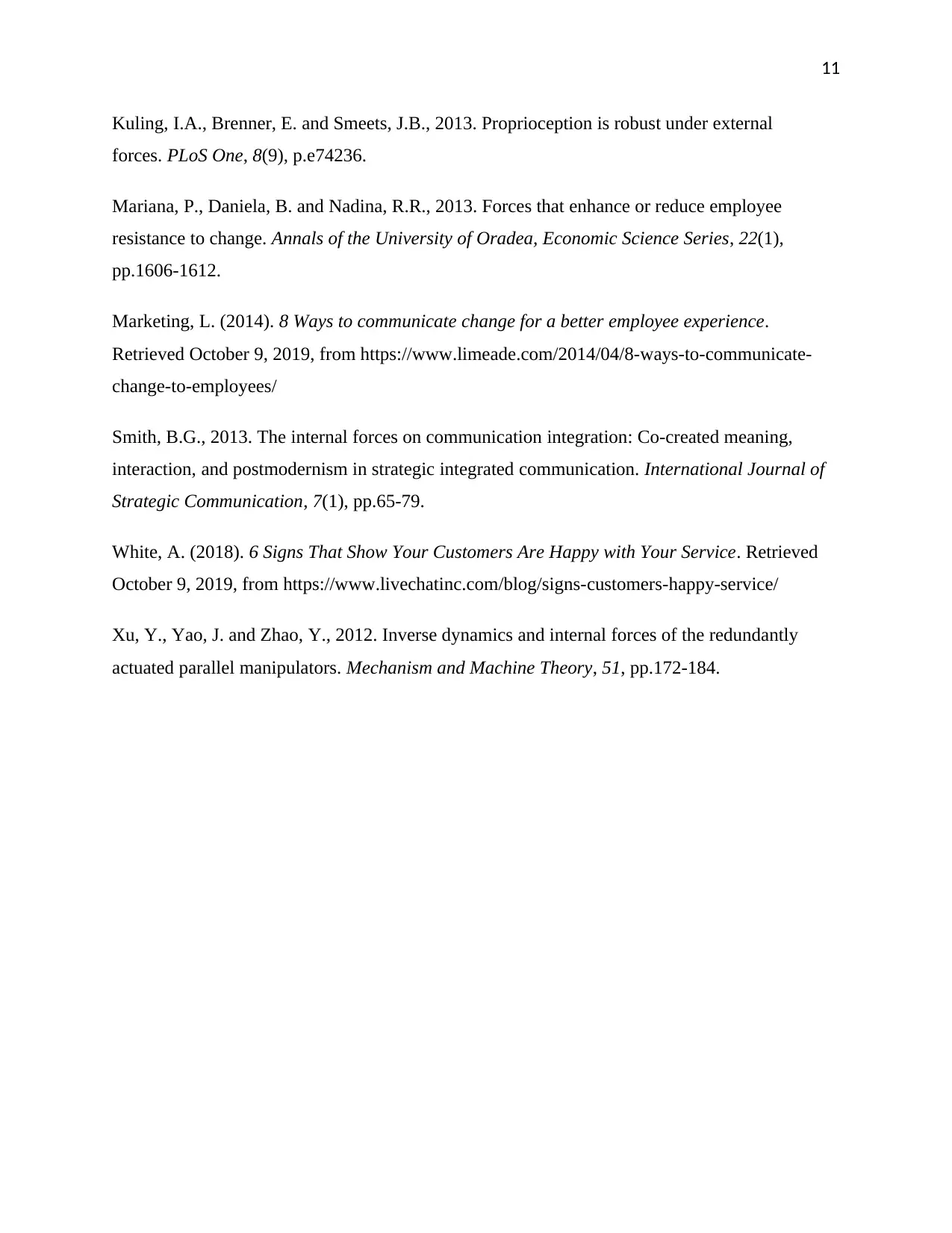
11
Kuling, I.A., Brenner, E. and Smeets, J.B., 2013. Proprioception is robust under external
forces. PLoS One, 8(9), p.e74236.
Mariana, P., Daniela, B. and Nadina, R.R., 2013. Forces that enhance or reduce employee
resistance to change. Annals of the University of Oradea, Economic Science Series, 22(1),
pp.1606-1612.
Marketing, L. (2014). 8 Ways to communicate change for a better employee experience.
Retrieved October 9, 2019, from https://www.limeade.com/2014/04/8-ways-to-communicate-
change-to-employees/
Smith, B.G., 2013. The internal forces on communication integration: Co-created meaning,
interaction, and postmodernism in strategic integrated communication. International Journal of
Strategic Communication, 7(1), pp.65-79.
White, A. (2018). 6 Signs That Show Your Customers Are Happy with Your Service. Retrieved
October 9, 2019, from https://www.livechatinc.com/blog/signs-customers-happy-service/
Xu, Y., Yao, J. and Zhao, Y., 2012. Inverse dynamics and internal forces of the redundantly
actuated parallel manipulators. Mechanism and Machine Theory, 51, pp.172-184.
Kuling, I.A., Brenner, E. and Smeets, J.B., 2013. Proprioception is robust under external
forces. PLoS One, 8(9), p.e74236.
Mariana, P., Daniela, B. and Nadina, R.R., 2013. Forces that enhance or reduce employee
resistance to change. Annals of the University of Oradea, Economic Science Series, 22(1),
pp.1606-1612.
Marketing, L. (2014). 8 Ways to communicate change for a better employee experience.
Retrieved October 9, 2019, from https://www.limeade.com/2014/04/8-ways-to-communicate-
change-to-employees/
Smith, B.G., 2013. The internal forces on communication integration: Co-created meaning,
interaction, and postmodernism in strategic integrated communication. International Journal of
Strategic Communication, 7(1), pp.65-79.
White, A. (2018). 6 Signs That Show Your Customers Are Happy with Your Service. Retrieved
October 9, 2019, from https://www.livechatinc.com/blog/signs-customers-happy-service/
Xu, Y., Yao, J. and Zhao, Y., 2012. Inverse dynamics and internal forces of the redundantly
actuated parallel manipulators. Mechanism and Machine Theory, 51, pp.172-184.
1 out of 12
Related Documents
Your All-in-One AI-Powered Toolkit for Academic Success.
+13062052269
info@desklib.com
Available 24*7 on WhatsApp / Email
![[object Object]](/_next/static/media/star-bottom.7253800d.svg)
Unlock your academic potential
© 2024 | Zucol Services PVT LTD | All rights reserved.





